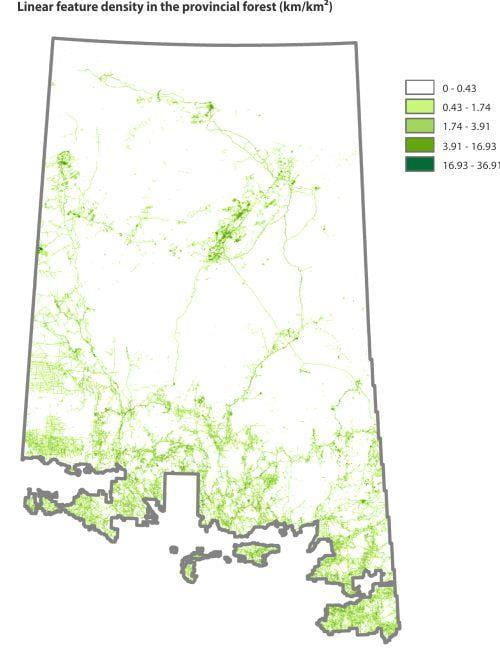
Understanding current disturbance levels within the provincial forest is important for assessing the cumulative impacts of human-caused disturbances. The ministry is establishing a baseline measurement of non-permanent and permanent linear features such as roads, transmission lines, railways, seismic lines, cut-lines and firebreaks in the provincial forest.
What's happening

What we are doing
Cumulative impacts are changes in an environment caused by multiple human activities and natural processes across space and over time. In addition to documenting linear features in an area, it is important to track road construction and reclamation by forestry licence holders. More stringent management of construction and reclamation activities will reduce the disturbance footprint of non-permanent and permanent roads associated with a variety of developments.
High levels of linear features in an area may require higher levels of mitigation to manage new development, and a greater need to reclaim features to maintain landscape integrity. The ministry is currently working on a mitigation framework that will determine how to reduce cumulative impacts in Saskatchewan. The economic impact to industry development in regions with a high linear density needs to be evaluated.
As a condition of their operating plans, forest licensees are required to reclaim forestry road access associated with forest harvest activities. The kilometres of forestry road access (class 1, 2 and 3 roads) constructed and reclaimed annually is used as base information for future road construction and reclamation activity reporting.

Linear feature density in the provincial forest
Linear feature density in the provincial forest is the total length of line features per square kilometre. Linear features include roads, trails, transmission lines, railways, seismic lines, cut-lines and firebreaks.

Why it matters
Disturbances within the forest may have an impact on timber and non-timber values. Increased road and trail access can increase recreational opportunities for the community, but also increase access to the forested areas for other users. Disturbance levels can indicate levels of commercial or non-commercial forest use as well as indicate an amount of disturbance within ecosystems. Disturbances affect the amount and quality of habitat available for different forest species.
Measuring linear feature density on a landscape is important because linear features can result in forest loss, fragmentation and degradation. Linear density is a common measurement of cumulative impacts across different ecosystems and jurisdictions, and is tracked over time.
Anecdotal evidence suggests that recreational use of Saskatchewan forests increases where roads are available. Forest users have reported reduced wildlife sightings in areas where they also reported increased numbers of hunters using forest access roads.




